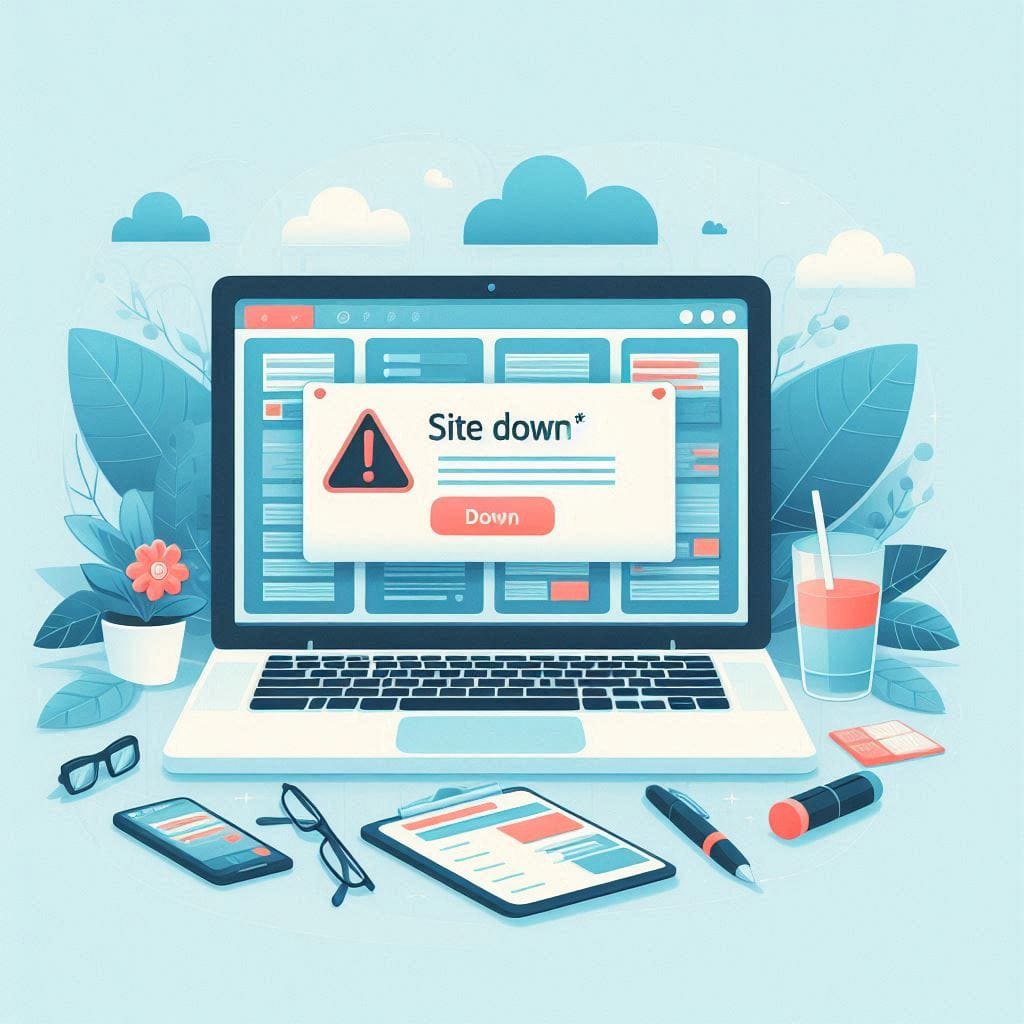Last Updated on by Azib Yaqoob
Imagine this: You’ve just published a blog post, shared it on LinkedIn, and scheduled an email campaign to drive traffic. But a few hours later, your website goes down—and you have no idea.
Visitors see a “This site can’t be reached” message. They leave. They don’t come back. Google notices too, and it can impact your rankings.
This is downtime—and it can quietly kill your business momentum.
Whether you’re a solo coach, run a law firm, or manage an eCommerce brand, monitoring your WordPress website for downtime isn’t optional—it’s part of running a reliable business.
Table of Contents
What Is Website Downtime?
Website downtime is any period during which your website is inaccessible to users. This can range from seconds to hours.
Downtime can be caused by:
- Server overload or crashes
- Plugin or theme conflicts
- Expired domains or SSL certificates
- Malware or hacking attempts
- Hosting provider outages
- DDoS attacks
Even a few minutes of downtime can lead to lost traffic, especially if it happens during peak hours or ad campaigns.
Why Monitoring Downtime Matters (Especially for SEO and Trust)
- User Trust: 79% of users won’t return to a site they couldn’t access the first time.
- SEO Impact: Googlebot may crawl during an outage. Repeated failures can lead to deindexing or lower rankings.
- Lead Loss: If your site is down during a campaign or after a podcast mention, you miss high-intent leads.
- Client Perception: You look unreliable. People may think you’ve shut down or gone out of business.
How to Monitor Your WordPress Website for Downtime (Step-by-Step)
1. Use Third-Party Uptime Monitoring Tools
These tools ping your website at regular intervals (every minute, 5 minutes, etc.) and alert you if they don’t get a response.
🔧 Best Uptime Monitoring Tools:
| Tool | Free Plan | Check Interval | Notification Types |
|---|---|---|---|
| UptimeRobot | Yes | 5 mins (1 min paid) | Email, SMS, Slack |
| Better Uptime | Yes | 3 mins | Email, SMS, Calls, Integrations |
| StatusCake | Yes | 5 mins | Email, Webhook |
| Pingdom | No | 1 min | Advanced reporting |
✅ Pro Tip: Set checks for both your homepage and key landing pages (e.g., /contact or /services) to monitor deep-link availability too.
2. Enable Server-Level Monitoring
If you use managed WordPress hosting, chances are they already monitor server health. Look for hosts that offer:
- Uptime guarantees
- Auto-restart for crashed services
- Instant alerts via email or dashboard
- Historical uptime reports
Recommended hosts with solid uptime monitoring:
Kinsta, Cloudways, WP Engine, Rocket.net
Avoid cheap shared hosting—they often hide outages behind vague explanations.
3. Get SSL & Domain Expiry Alerts
Downtime isn’t just about server issues. If your domain expires or your SSL certificate isn’t renewed, your site will either break or be blocked by browsers.
✅ Use services like:
- WhoisXML for domain expiry monitoring
- SSLMate or CertSpotter for SSL expiry alerts
- Better Uptime (includes both in its checks)
4. Set Up WordPress-Specific Alerts
Some plugins help you stay informed about:
- Plugin/theme conflicts
- PHP errors
- High resource usage
- Login attempts or file changes
🔌 Recommended plugins:
- WP Health Check
- Query Monitor
- WP Activity Log
- Jetpack Monitor (simple uptime alerts)
Remember: plugins can’t notify you if the whole site is down, so don’t rely on them alone.
How Often Should You Check for Downtime?
With modern monitoring tools, you can check as often as every 60 seconds. That’s 1,440 checks a day.
For most businesses, a 5-minute interval is enough.
If your site has:
- High daily traffic
- Paid campaigns running
- Clients depending on logins/bookings
…you should aim for 1-minute intervals.
Here’s a quick incident response checklist:
- Confirm the Downtime: Use your uptime dashboard or tools like
downforeveryoneorjustme.com. - Check Hosting Status: See if your provider has a reported outage.
- Review Logs: Server logs or plugin logs might give clues (if accessible).
- Restore a Backup: If caused by a plugin update or hack.
- Contact Support or Dev: If you can’t solve it alone.
- Notify Visitors: Use a status page, social media, or email alerts if downtime persists.
✅ Pro Tip: Always keep recent off-site backups (not just the ones stored with your host).
FAQs About WordPress Downtime Monitoring
Q: Can I use a free tool to monitor downtime?
Yes. Tools like UptimeRobot and Better Uptime have great free plans for single-site monitoring.
Q: Will Google penalize my site for being down?
Short downtimes usually have no impact. But repeated outages or long periods of downtime can hurt your rankings.
Q: What’s the difference between uptime monitoring and performance monitoring?
Uptime monitoring checks if your site is online. Performance monitoring checks how fast your site loads and behaves.
Q: Can I set up SMS alerts for downtime?
Yes. Most tools offer SMS alerts. Some (like Better Uptime) even offer phone calls if your site goes offline.
Final Thoughts: Make Downtime One Less Thing to Worry About
Website downtime is easy to ignore—until it costs you. Monitoring it is one of the simplest ways to protect your traffic, leads, and brand.
And if you don’t want to set this all up yourself? I help professionals and small teams build reliable WordPress sites that stay online and secure.
👉 Let’s talk about a maintenance plan that gives you peace of mind.

